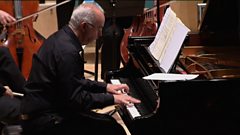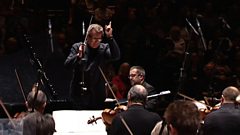Mozart: Piano Concerto No. 27
Charles Hazlewood and pianist Ronald Brautigam examine Mozart's last piano concerto, K.595 in B flat.
Piano Concerto No. 27 in B flat major, K.595 (1788–91)
1 Allegro
2 Larghetto
3 Allegro
The special position this concerto holds in the affections of Mozart-lovers owes much to its particular qualities, of course, but also to the notion that, completed on 5 January 1791, it expresses the resignation and weariness of spirit which had overtaken the composer after two years of dwindling success and reduced productivity. And it cannot be denied that such an interpretation suits this gentle work, in which the ebullient virtuosity and extrovert gestures which had characterised the great piano concertos of the mid-1780s are rejected in favour of an altogether more personal species of utterance, as if Mozart had tired of the rat-race of public display. Modern research, however, has forced us to modify this view of the work, for it now appears that it was drafted in incomplete score as early as 1788. Perhaps Mozart shelved it when the prospect of a performance vanished, while his return to it at the start of 1791 may well have been in response to the need for a work to play at a benefit concert for the clarinettist Joseph Bähr on 4 March.
This is not to diminish K595. If its wistful lyricism can no longer be slotted quite so conveniently into the details of Mozart’s life – and if it is no longer the ‘work of farewell’ that one influential 20th-century Mozart scholar dubbed it – then its purely musical value as a composition of noble and restrained beauty remains for all to hear.
Like the Symphony No. 40, it opens with a bar of accompaniment before the first theme appears, a yearning, looping violin melody that sets the mood for the rest of the movement. As the opening orchestral section progresses a feeling of longing persists, reinforced by the music’s frequent turns to the minor, and the atmosphere hardly changes at the entry of the soloist where, instead of the usual operatic opposition of melodic material, we find the piano coming in with an uncontroversial restatement of the first theme. Thereafter it is content to contribute only one agonised new theme of its own and, after the central development section has rumbled through a multitude of keys without letting its surface smoothness slip, the movement closes in the same quiet vein in which it had started.
The resigned and unargumentative mood of this first movement carries over into the second, an E flat major Larghetto in a three-part A–B–A form. As in the first movement soloist and orchestra are here very much in thematic and spiritual accord, with the other instruments providing unquestioning support for the piano’s quiet complaints, offering sympathy and occasional outbursts of consolatory warmth. This is music whose elegant simplicity of expression easily matches that of the more celebrated slow movement of the Piano Concerto No. 21 (in C major, K467).
The final rondo brings something, at least, of the brilliance of Mozart’s earlier concertos, but if its playful demeanour suggests that the composer has turned his back on the sadnesses of the preceding movements, a continued flirtation with the minor mode and an insistent preoccupation with the least stable part of the principal returning theme are enough to remind us of less complacent emotions. The resulting faintly nostalgic feel makes a fitting close to a work in which, perhaps, we can after all hear Mozart recalling happier days.
Programme note © Lindsay Kemp
The complete performance is not available for rights reasons.
Duration:
Credits
| Role | Contributor |
|---|---|
| Composer | Wolfgang Amadeus Mozart |
This clip is from
Featured in...
![]()
Discovering Mozart—Composer of the Week
Listen to programmes examining the life and works of Wolfgang Amadeus Mozart.
More clips from Discovering Music
-
![]()
Watch an analysis of Debussy's La mer—Debussy's La mer
Duration: 41:43







